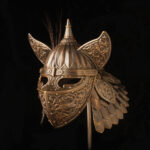My journey with the Fancy Feast Cat Food stove began with a gift from Ryan Bozis (Major Slacker), at a presentation in Virginia back in Spring 2006. Initially, I was skeptical. Having relied on a more intricate double-walled stove made from Red Bull cans during my Sea-to-Sea Route hike, the simplicity of the Fancy Feast design didn’t immediately impress me. It seemed too basic to outperform my existing setup.
However, curiosity and a desire for optimization led me to put the Fancy Feast stove to the test against my trusted Red Bull can stove and several other designs. To my surprise, the Fancy Feast stove emerged as the champion in both speed and fuel efficiency. Beyond performance, it was also slightly lighter, required fewer materials and minimal construction time, translating to almost no cost. The ingenious design also served as its own pot stand, streamlining my entire cooking system. Another significant advantage was the elimination of pre-heating. Since that summer of 2006, this humble cat food can stove has been my go-to for backcountry cooking.
 Complete Fancy Feast cat food stove setup for backpacking, showing the lightweight DIY alcohol stove with windscreen and pot, ideal for ultralight camping.
Complete Fancy Feast cat food stove setup for backpacking, showing the lightweight DIY alcohol stove with windscreen and pot, ideal for ultralight camping.
Key Features and Benefits of the Fancy Feast Cat Food Stove
- Ultralight Weight: Weighing in at a mere .3 oz (approximately 10 grams), this stove is a featherweight addition to your backpacking gear.
- Budget-Friendly: The cost is incredibly low, around $.50 for the Fancy Feast cat food can (including tax) and $3-$5 for a hole punch.
- Durable and Reliable: With no moving parts, the Fancy Feast stove is incredibly robust. It will never clog, and even if accidentally crushed, it’s often possible to reshape it and continue using it.
- Integrated Pot Stand: The stove’s design eliminates the need for a separate pot stand, reducing the number of items you need to carry.
- Readily Available Fuel: It burns denatured alcohol, a cheap and widely accessible fuel. You can find it in hardware stores (paint department), gas stations (as HEET gas-line antifreeze), and hiking hostels. Everclear or grain alcohol can also be used, though these are more expensive options. Denatured alcohol is easily stored in standard plastic bottles.
- Fuel Efficient: It typically uses about .6 oz of denatured alcohol to boil 1.5 cups of water in 5-7 minutes, depending on your pot, water temperature, and windscreen efficiency.
Drawbacks to Consider
- Stability with Larger Pots: The 2.5-inch diameter of the Fancy Feast can might not provide sufficient stability for larger pots. For bigger cookware, consider using a larger can like a tuna fish can instead.
- Flame Distribution for Small Pots: Smaller pots, such as 600 ml mugs, might not receive enough direct flame due to the side-burner design. A top-burner model might be more efficient for very small volumes.
- No Flame Control: This stove lacks a simmer function, offering no control over flame intensity. This is perfectly adequate for simple backcountry cooking that primarily involves boiling water for dehydrated meals.
- No “Off” Switch: The stove burns until all the fuel is consumed. To extinguish it, you need to smother it with a pot, mug, dirt, or water. Blowing it out is extremely difficult.
- Slower Boil Times Compared to Pressurized Stoves: It is not as fast as white gas or canister stoves. If speed is paramount, and you’re willing to carry extra weight, pressurized stoves might be preferable. However, the few extra minutes of boil time can be used for other camp tasks.
Materials You’ll Need to Make Your Fancy Feast Stove
- 3-oz Fancy Feast cat food can (or similar sized can). Generic brands often work just as well and may be even cheaper.
- Single-hole punch. A standard hole punch is sufficient, but a long-reach craft punch makes the hole-punching process easier.
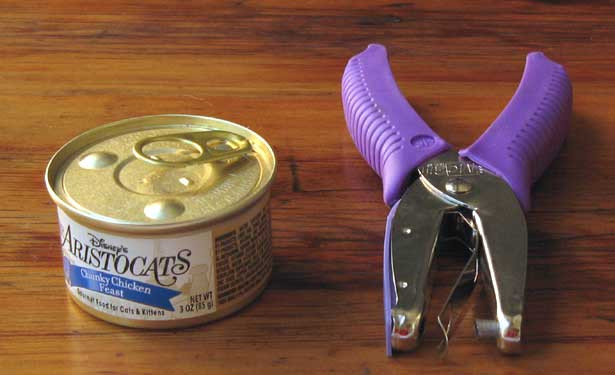 Essential supplies for building a DIY Fancy Feast cat food stove: a cat food can and a hole punch, demonstrating the simple tools needed for this ultralight backpacking stove project.
Essential supplies for building a DIY Fancy Feast cat food stove: a cat food can and a hole punch, demonstrating the simple tools needed for this ultralight backpacking stove project.
Step-by-Step Instructions to Build Your Stove
Watch the video tutorial for a visual guide!
- Prepare the Can: Remove the cat food and thoroughly wash the empty can.
- Smooth the Edge: Flatten the sharp edge left by the lid using the hole punch or a butter knife to prevent cuts.
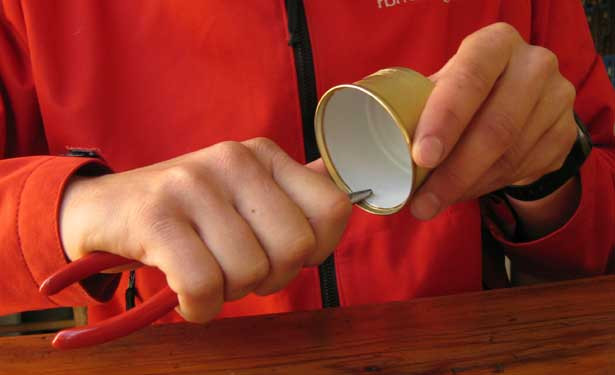 Step-by-step guide to making a Fancy Feast cat food stove: Flattening the sharp edge of the can with a hole punch for safety, a crucial step in this DIY backpacking stove tutorial.
Step-by-step guide to making a Fancy Feast cat food stove: Flattening the sharp edge of the can with a hole punch for safety, a crucial step in this DIY backpacking stove tutorial.
- Punch the Top Row of Holes: Just below the can’s lip, create a complete row of holes using the hole punch. Space the holes about one-eighth of an inch apart to avoid tearing the can.
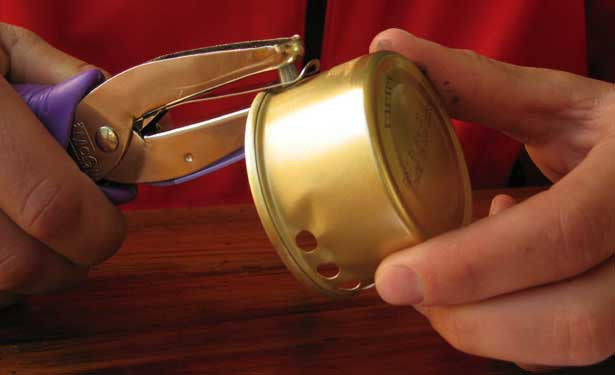 Creating the top row of holes on a Fancy Feast cat food can for a DIY alcohol stove, illustrating the hole placement for optimal fuel efficiency in this homemade camping stove design.
Creating the top row of holes on a Fancy Feast cat food can for a DIY alcohol stove, illustrating the hole placement for optimal fuel efficiency in this homemade camping stove design.
- Punch the Bottom Row of Holes: Below the first row, create a second row of holes. Position these bottom holes directly underneath the gaps between the top row of holes.
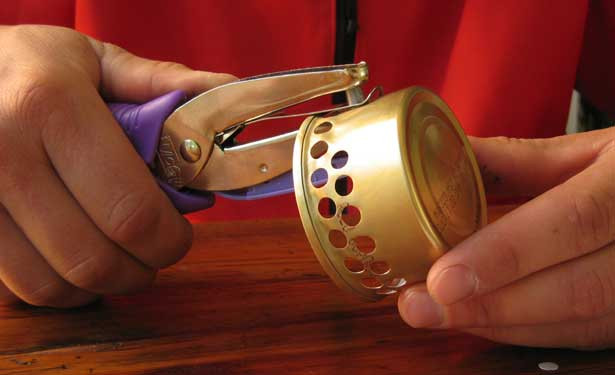 Adding the bottom row of holes to a Fancy Feast cat food stove, offset from the top row to enhance combustion and performance of this ultralight backpacking stove.
Adding the bottom row of holes to a Fancy Feast cat food stove, offset from the top row to enhance combustion and performance of this ultralight backpacking stove.
- Create a Windscreen: A windscreen is essential for efficient operation. Follow a separate guide to make your own windscreen. A windscreen is crucial, especially in windy conditions, to achieve a boil.
How to Use Your DIY Cat Food Can Stove
Using the Fancy Feast stove is incredibly straightforward.
- Fueling: Pour denatured alcohol into the stove.
- Ignition: Light the alcohol with a match or lighter.
- Warm-up: Allow 20-30 seconds for the fuel to heat up and the stove to prime.
- Cooking: Place your pot on top of the stove.
For optimal fuel efficiency and meal texture, I often boil slightly less water than required for my dehydrated meals. After the food absorbs the boiled water, I add non-boiled water to reach the desired consistency. This method saves fuel, prevents “soupy” meals, and cools down the food to an eating temperature quickly.
 The efficient flame of a Fancy Feast cat food stove in action, demonstrating its powerful cooking capability for backpacking meals, a lightweight and reliable DIY camping stove solution.
The efficient flame of a Fancy Feast cat food stove in action, demonstrating its powerful cooking capability for backpacking meals, a lightweight and reliable DIY camping stove solution.
Variations and Considerations
The standard 3-oz Fancy Feast stove is perfect for solo backpacking with pots around 1 liter. I personally use a .9-liter Evernew titanium pot with a 5-inch base diameter. If you plan to use larger pots and are concerned about stability, using a larger can, like a tuna can, following the same construction method, is a viable option.
While I haven’t conducted rigorous testing, it’s reasonable to assume that the number of holes influences the stove’s heat output and fuel efficiency. More holes likely result in a hotter but less fuel-efficient burn, while fewer holes might lead to a cooler but more efficient flame. The ideal number of holes likely depends on various factors such as pot material, water volume, and windscreen performance, making extensive testing impractical.

